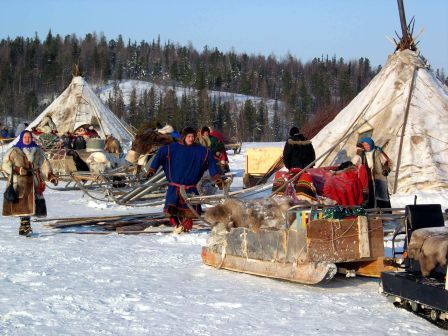Indigenous peoples in the Arctic are one of the most vulnerable to the climate change effects and extremely susceptible to its direct adverse consequences which partly own their significant relationship with the natural environment and its resources. The knowledge about climate change effects on aboriginal livelihoods comes mostly from the experience and carful observations while interacting with the natural environments.
Compering the experience of indigenous people from all over the northern hemisphere, large number of common issues emerge. The Intergovernmental Panel on Climate Change reflected that the climate change has been greatly affecting the remote Arctic livelihoods.
However, the United Nations Framework Convention on Climate Change neither the Kyoto Protocol does not explicitly discuss the matter of indigenous and traditional people with regards to the global problem of climate change. Nevertheless, since early 21st century, the indigenous representatives via their organizations have been involved in climate change negotiation and released great number of statements, reports and declarations in which they have been expressing their concerns about the climate change current policy.
Recently, the most visible features of changing climate in the Arctic are the vacillating weather conditions. The statistics inform that the atmospheric conditions seem to be very unstable and almost impossible to be predicted by traditional approach which used to be the only reliable method for indigenous communities. The winter season brings more rain and less snow to northern regions and the summer pattern extends what makes the water level drop in lakes and the sea ice to decline.
It was reported that animal species which have not been seen in the Arctic before, inhabit its ecosystems. In the northern parts of Canada, indigenous groups noticed the reduction of some seal species in the areas where the sea ice gets thinner. Instead, the unknown species of birds and insects occurred. Having a great impact on indigenous culture, climate change causes a problem of survival not only for seals, which are the single most important food source for Inuit, but also for polar bears which are not likely to stay alive in warmer summer conditions.
According to the meteorological research, increased amount of summer storms has been growing annually causing the natural erosion of coastal areas. What is more, the Saami from northern, European Arctic has observed that advancing wind speed confuse the navigational instincts of reindeers what forces changes in traditional travel paths.
Besides having a great impact on indigenous peoples 'culture, food security and traditional lifestyle, climate change greatly effects human health. Because of longer and warmer summers, sun seems to feel stronger and sharper what causes unknown among remote northern communities, skin rashes and even cancer.
The governments of the Arctic states came together with the joint forces to create the framework for climate change mitigation. Indigenous communities of Polar Regions as well as North America have been greatly included in the reports. Taking into the account that the cost of climate change is mainly handled by the rather poor, natural resource dependent communities, the importance of monetary, technology and knowledge transfer from developed countries is being adopted.









